
About Andrew Cusack
 Writer, web designer, etc.; born in New York; educated in Argentina, Scotland, and South Africa; now based in London.
Writer, web designer, etc.; born in New York; educated in Argentina, Scotland, and South Africa; now based in London. read more
News
Blogs
Reviews & Periodicals
Arts & Design
World
France
Mitteleuropa
Knickerbockers
Argentina
The Levant
Africa
Cape of Good Hope
Netherlands
Scandinavia
Québec
India
Muscovy
Germany
Academica
Columbus Circle and the Human Scale
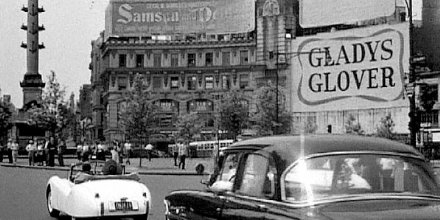
Meandering through the internet yesterday, I came across the above image from the 1954 film ‘It Should Happen to You!’ (via a New York Times article). The film capture shows Columbus Circle in 1954 and was I immediately struck by the superiority of the scale of the buildings to the street, especially compared to today when the Columbus Column is rather overshadowed by the AOL Time Warner Center. It’s not that I don’t like tall buildings; after all New York has some of the most beautiful skyscrapers in the world (though I can’t think of a single great one built after the second war).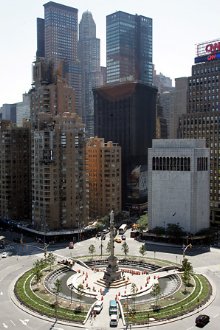 I don’t even object to the residential apartment buildings lining Central Park on Fifth Avenue and Central Park West, except for the fact that on Fifth Avenue they almost always replaced superior, smaller buildings. However, with a public square as small as Columbus Circle, it somehow seems as if lower buildings of only 3-10 storeys would be more appropriate.
I don’t even object to the residential apartment buildings lining Central Park on Fifth Avenue and Central Park West, except for the fact that on Fifth Avenue they almost always replaced superior, smaller buildings. However, with a public square as small as Columbus Circle, it somehow seems as if lower buildings of only 3-10 storeys would be more appropriate.
The latest brouhaha concerns No. 2 Columbus Circle (the shorter, white building in the photo on the right), designed in the early 1960’s by Edward Durell Stone to house the art collection of Huntington Hartford. The current owners want to chic-ify the building by taking off the façade and recladding No. 2 in the more fashionable glass, akin to the neighboring Time Warner Center, and this has roused the ire of many of New York’s preservationist crowd. Though No. 2 has its charms, I’m not a huge fan of the building myself, but the redesign would only make it worse. The chief value of the building is its comparitively low height which, when viewed from the northwest, contributes to the feeling as if the midtown buildings are gradually lowering in height to meet the scale of Columbus Circle. Unfortunately the Time Warner Center doesn’t comply well with this lessening scale, though it at leasts goes through the motions by have a consistent, low base from which its two towers rise. The stone cladding of the Center, however, is rather too dark and gives a slightly gloomy feel to what ought to be a lovely, bright place.
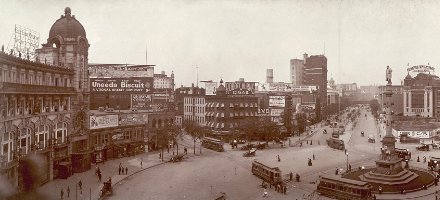
In this photo from the 1900’s, you can see the scale of the buildings starts out rather small and humane, and the design of the buildings is generally dignified.
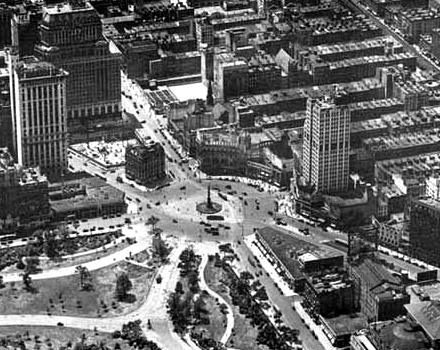
By the 1920’s a number of taller buildings have emerged, but two buildings facing the circle (on the left between Central Park South and Broadway and on the right between Central Park West and Broadway) are actually too low to suitably complement the open space.
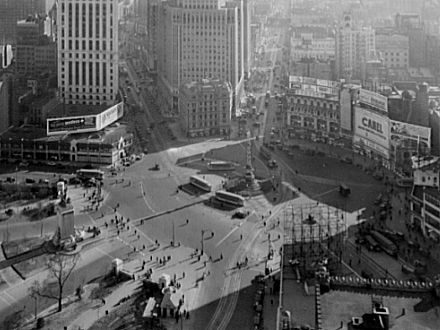
In the 1930’s (above and below) we see the further encroachment of the skyscraper, but again on the Circle the scale remains acceptable.
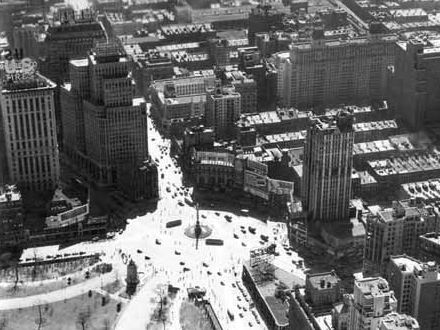
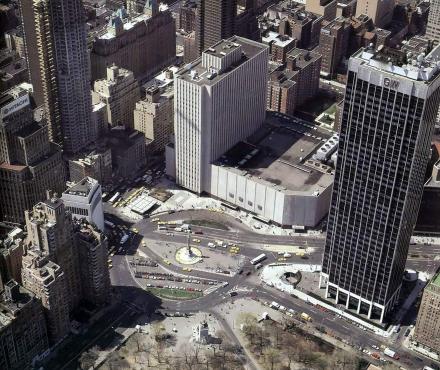
By the 1970’s, all hell had broken loose. The New York Coliseum, a convention center, was built in the 1950’s and consumed the entire western side of Columbus Circle with ugly public housing blocks behind it, and 59th Street’s access to the Circle was eliminated. The GW office building, later reclad in black metal and glass as a residential Trump building, towers over the Circle and takes up the entire triangle between CPW and Broadway. The pretty building which sat at 2 Columbus Circle has been replaced with the current inhabitant, twice the size of the previosu building but still small compared to the other towers.
One aspect in which Columbus Circle has undoubtedly improved, however, has been the interior of the circle itself. For decades the Columbus Column sat isolated in the middle of the Circle with cars, trolleys, and everything else given a wide breadth of access in the Circle. In the 1960’s, this was restricted somewhat with a little greenery added and some parking spaces of all things, but it wasn’t until last year that Columbus Circle was finally redesigned as a formal traffic circle with a large public space in the center, surrounded by fountains and greenery. The execution is somewhat modern but its minimalism is fairly inoffensive, and overall it constitutes a most welcome improvement. (See the topmost righthand photo for the finished redesign).
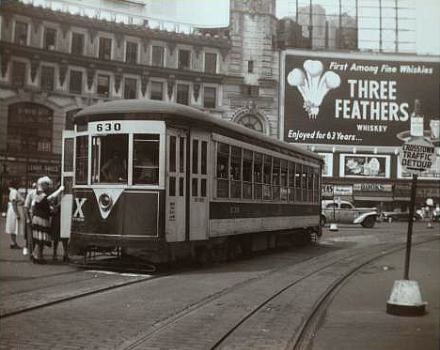
A tram in Columbus Circle, 1945.
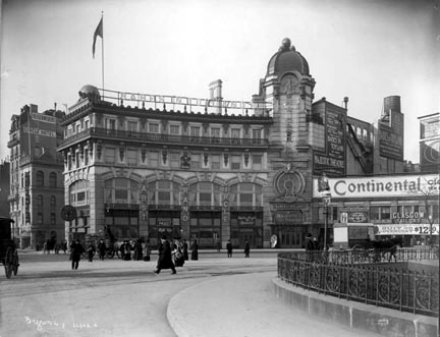
One of the most comely denizens of Columbus Circle in years past was the splendidly beaux-arts Majestic Theatre (above and below), built in 1903. Seating over 1,500, the Majestic was designed by John Duncan, the same architect who designed Grant’s Tomb on Riverside Drive.
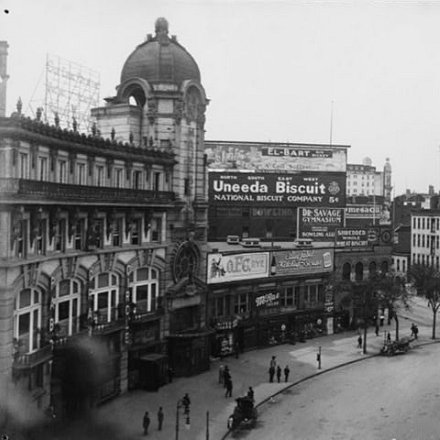
The Majestic was built on Columbus Circle because with the expansion of New York along the island of Manhattan, the theatre district continually moved further and further north. New York’s first theatre, if my memory serves me well, was the John Street Theatre built during the colonial period after the British seizure of the city from the Dutch, down in what is now the financial district. It then moved to the Bowery, then northwards to Union Square, further north to Madison Square, and then further up Broadway to Times Square. Logically speaking, the next location of the theatre district would be Columbus Circle and the area just north of it, but for one reason or another the theatre industry never made the leap and stayed in and around Times Square, where it fundamentally remains to this day. Aside from the Majestic, however, the thought that it was going to move north again led to the construction of the New Theatre on Central Park West and 62nd Street. Designed by Carrère and Hastings, also responsible for the New York Public Library, and opening in 1909, the New Theatre sat 2,300 and was envisioned as the home of a permanent non-commercial reperatory company along the lines of the Comédie Française. The New Theatre was probably the most beautiful theatre building ever to grace the island of Manhattan, but its poor accoustics and awkward location combined made it a complete failure. It was renamed the Century and became a general-interest theater but was eventually torn-down in the 1920’s and the Century Apartments were built in its place. The Majestic itself lasted until 1954, when it was torn down for the construction of the New York Coliseum and Convention Center, which itself lasted until 1999-2000, when it was demolished to make way for the Time Warner Center.
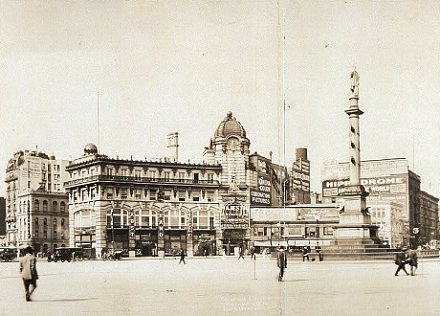
Search
Instagram: @andcusack
Click here for my Instagram photos.Most Recent Posts
- Burns Tower April 19, 2024
- Patrick in Parliament March 18, 2024
- Articles of Note: 13 March 2024 March 13, 2024
- Cambridge March 9, 2024
- Taken on Trust March 4, 2024
Most Recent Comments
Book Wishlist
Monthly Archives
Categories



Andrew, you are right on this. Nice post. The first time I recalled seeing Columbus Circle I was very underwhelmed. Columbus Circle appeared more like an by-product of design rather than an intentionally designed. I’ve never accounted for the overwhelming effect of the skyscrapers have on the original design.
Andrew, great post. I will be sending the link to friends who know only the current incarnation of the circle. As I scrolled down, I kept hoping one of your photos would be wide enough to the East in order to capture the City House of the NYAC, but this was not to be.
I really like your [MORE]. Is is new?
Indeed. Just changed it a few days ago. It used to be boring old Times New Roman.
Great article! I always wondered what that mysterious #2 building was. I thought somehow it was some kind of telephone exchange building… now I find out it was built to house an art collection!
Andrew,
what is the source of these great photos? I am seeking archival photos of both Times Square and Columbus Circle from the early 1900’s and am wondering if these are in the public domain?
I am researching for a documentary and need to find the source and would appreciate any assistance you can provide.
thanks!
Andrew–
I have platnium prints of NYC from 1900-1906 when the subway was being build. I am not sure if you or someone you know would be interested in these.
I very much enjoyed the post. I used to live in the building “the Park Vendome” from the 70’s to 2006 and saw some of the architectural changes. I remembered how rapidly with the contruction of the Time Warner building they took to demolish the Coliseum as well as the reclad of the GM building by Trump
The Parc Vendome is seen at 1 oclock in the first B & W picture under the sepia picture. There use to be a book store called the the Coliseum on 57th street the owner lived in the Park Vendome and was forced to close because of the sudden doubling of his rent.
The Hearst building was not even built in the picture (circa 1920) As the Theater district expanded north many actors rented appartment at the Parc Vendome before it became a condo. The appartments had small kitchens since most theater district workers/actors etc.. ate out. The Parc Vendome almost became bankrupt after the tax law changes 1980’s and the Rose family who own the Sheffield bought the underground of the Park Vendome to build parking.
My Father in law’s father was a trolley conductor in NYC,
Used to work at St. Clare Hospital 9th ave 51st. Closed now. So many business opened and closed amazing….
Thank you for the pictures
David